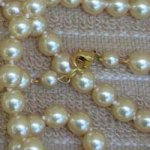rivermandave
Community member
- Joined
- Jul 22, 2014
- Messages
- 27
The gold colored pearls have a knot in between eash one. I don't think that someone would take the time to do that if they weren't real.
Your reasoning seems logical here, except knotting between imitation pearls is done just for that reason~to make them seem more realistic. The way this necklace is finished near the clasp also indicates they are likely imitation pearls. Hopefully I will have a chance to look at the other photos and comment later today.

Does the clasp have any markings? They are very perfect beads with what looks like a brass clasp and no proper finish to the ends at the clasp. I don't think they are cultured pearls, but they sure do fool the eye when someone wears them. Check them as KarinK suggested- if they are smooth they are manufactured. if cultured they will have a faint gritty feel. Even for cultured pearls the colors, shapes and sizes are too matchy-matchy for the quality of the clasp.
Lots of imitation pearls are glass with an imitation pearlescent coating. These are a bit heavier than real pearls. I have to say those look imitation.
No the coating would not prevent anyone who knows pearls and has a loupe from telling whether they are real. I would conclude that the jeweler you spoke with has little experience with or knowledge about pearls. This isn't unusual, by the way.
You rubbed two of the pearls gently against each other, right? If they slide easily against one another, that indicates they are imitation.
If the jeweler you visited sells real cultured pearls, ask to use her loupe to look at the surface of her pearls close up, then compare with your strand. Real nacre has a very fine, smooth appearance. Imitation pearl coatings are more textured looking, something like an orange peel. The worse the quality, the coarser the surface. Even my best imitation strands (Majorica) look coarser under 10x magnification than my least expensive freshwater pearls.
You could also visit any thrift store-- these always seem to have imitation pearls strands for sale. Handle some of their imitation pearls. Rub two of the known-fake pearls together. Feel what that is like. Compare with your own strand.
IMO anyone who buys or sells jewelry should buy themselves a 10x triplet loupe. They don't cost a lot and they are so useful! Here is one listing, I'm sure you can find more:
http://www.riogrande.com/Search/10x-loupe
This thread may also interest you:
https://www.pearl-guide.com/forum/showthread.php?t=7110
Would the coating prevent a jeweler from being able to tell whether they are real or not?....
Riverman Dave,
The brass head pin is characteristic of Japan 60's era head pins manufactured for use by high end costume jewelry designers like Miriam Haskell who used faux pearls extensively. Whether it's real or not, the strand is lovely and someone will enjoy wearing it.
Congrats on having the Mississippi River pearls identified! What a nice thing to own!
These sorts of threads are great for readers. There is so much to be learned about pearls!